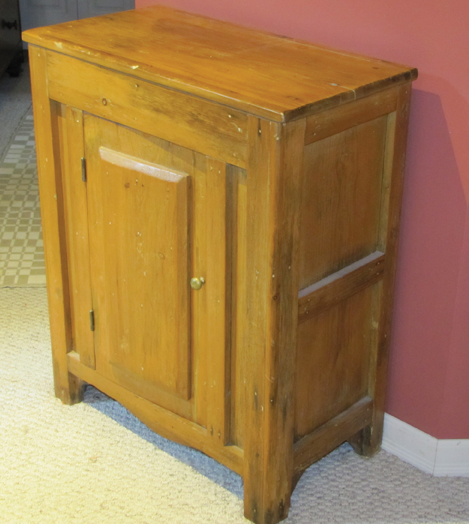Hello Shaun,
This is a pine cupboard that we found many years ago. My husband refinished the piece as it was covered in several layers of paint. As you can see it has a single door. It is roughly 40” in height, 30” in width and 20”deep. I imagine it was used for storage purposes. I would appreciate any information you could provide including a current value.
Thank you,
Barbara
–
Hi Barbara,
Thank you for sending along the photo of your interesting cupboard. This piece falls into that category of antique furniture, which we commonly refer to as “Canadiana” or “country” furniture.

Country furniture, as the name implies, was largely made in rural areas and from what you’ve told me, this piece was found in the Ottawa Valley.
Of course, the timber industry was the original raison d’etre for the settlement of the Valley but once the forests were cleared, immigrant farmers, many from Ireland, England and Scotland, set about tilling the land. The majority of them also worked “in the bush” during the winter, continuing to harvest the majestic white pines that were floated down the rivers and off to England for use in ship building and other applications.
The interest in Canadian country furniture really caught the imagination of collectors at the time of this country’s centennial celebration in 1967. That’s when the first serious wave of collectors started to search out these hand made pieces and the accessories that were made alongside them.
At the time, collectors were quick to remove or “strip” the paint from pine furniture. They wanted to see and enjoy the white pine from which these pieces were most always made. After a hundred or more years the wood had a “distressed” look that was further enhanced with a stain and varnish or shellac.
Today, while refinished pine antiques are still popular, serious collectors of Canadiana strive to acquire pieces in their original painted condition. They want to see the furniture and accessories in as close to the original state as possible with the natural wear that comes from 150 years of use. Interestingly, pieces in original paint fetch a much higher price these days than refinished furniture. Your little cupboard is in refinished condition. I imagine it would have had many layers of paint on it when first discovered.
Storage was an important requirement on the farms and in the homes of early Canadians. Cupboards were made usually on the farm or in the immediate vicinity.
Your piece has some interesting and attractive features and was obviously made by someone who was quite accomplished. The raised panel on the door is an amusing touch in that it appears to be a rectangular slab of wood that is affixed to the door. Raised panels on doors are usually fitted into a frame that surrounds the panel. Perhaps this maker wasn’t confident in his ability to construct such a door and opted to achieve the same end by mounting the raised panel directly on the door.
I should point out that most often panels in doors on antique cupboards are “flat” and surrounded by a frame. You can see that effect on the sides of your cupboard.
The vertical pieces of wood that form the corner structure are an interesting detail. Not only does this method provide for the corner construction, by extending them it provides the legs on which the little cupboard stands. The space between the front and back legs also elevates the cupboard from the floor, which is important.
Cupboards with flat bottoms that sit directly on the floor are prone to decay, especially if there is any dampness nearby or underneath.
The typical way of joining the sides together would be to use a dovetail or butt joint as opposed to constructing a 90 degree angle from two pieces of wood and affixing the front and side panels to them.
On the sides, about halfway, the maker added an additional horizontal member for more strength. Doing so created a “double panel” effect on each side. Typically, the top of a cupboard or washstand would have a slight overhang, which gives a cupboard a more finished look. In your case, the top might have been “trimmed” off or that may have been the way it was made originally.
The hinges on the door appear to be original, possibly cast iron, dating the cupboard to about 1870. I suspect this little cupboard was used in a kitchen. It’s also small enough that it might have started out life as a washstand.
The market for refinished pine furniture is quite soft these days. Perhaps it’s the economy or the fact there are so many other competing categories of collecting. In a shop, I think you’re cupboard would be priced at about $400. It would certainly cost that much – or more – if you had to replace it. Interestingly, if the cupboard had its original paint or an old secondary paint, it would probably be worth about $650.
In any event, it is a charming and interesting piece of furniture and would look right at home in any “country” collection.
Shaun Markey writes about antiques and folk art at folkartintheattic.blogspot.ca. Is there an antique you’re curious about? Email shaunmarkey@rogers.com. Your item – and its story – might be published in the next column.